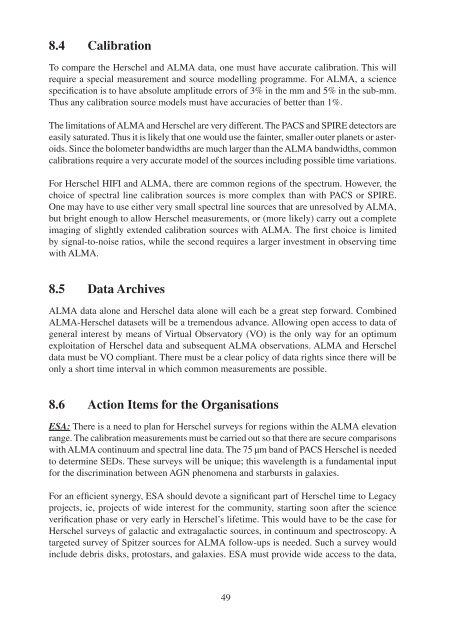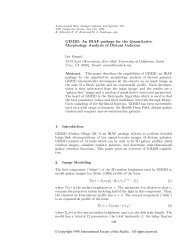4 Comparison of the ALMA and Herschel - ESO
4 Comparison of the ALMA and Herschel - ESO
4 Comparison of the ALMA and Herschel - ESO
Create successful ePaper yourself
Turn your PDF publications into a flip-book with our unique Google optimized e-Paper software.
8.4 Calibration<br />
To compare <strong>the</strong> <strong>Herschel</strong> <strong>and</strong> <strong>ALMA</strong> data, one must have accurate calibration. This will<br />
require a special measurement <strong>and</strong> source modelling programme. For <strong>ALMA</strong>, a science<br />
specification is to have absolute amplitude errors <strong>of</strong> 3% in <strong>the</strong> mm <strong>and</strong> 5% in <strong>the</strong> sub-mm.<br />
Thus any calibration source models must have accuracies <strong>of</strong> better than 1%.<br />
The limitations <strong>of</strong> <strong>ALMA</strong> <strong>and</strong> <strong>Herschel</strong> are very different. The PACS <strong>and</strong> SPIRE detectors are<br />
easily saturated. Thus it is likely that one would use <strong>the</strong> fainter, smaller outer planets or asteroids.<br />
Since <strong>the</strong> bolometer b<strong>and</strong>widths are much larger than <strong>the</strong> <strong>ALMA</strong> b<strong>and</strong>widths, common<br />
calibrations require a very accurate model <strong>of</strong> <strong>the</strong> sources including possible time variations.<br />
For <strong>Herschel</strong> HIFI <strong>and</strong> <strong>ALMA</strong>, <strong>the</strong>re are common regions <strong>of</strong> <strong>the</strong> spectrum. However, <strong>the</strong><br />
choice <strong>of</strong> spectral line calibration sources is more complex than with PACS or SPIRE.<br />
One may have to use ei<strong>the</strong>r very small spectral line sources that are unresolved by <strong>ALMA</strong>,<br />
but bright enough to allow <strong>Herschel</strong> measurements, or (more likely) carry out a complete<br />
imaging <strong>of</strong> slightly extended calibration sources with <strong>ALMA</strong>. The first choice is limited<br />
by signal-to-noise ratios, while <strong>the</strong> second requires a larger investment in observing time<br />
with <strong>ALMA</strong>.<br />
8.5 Data Archives<br />
<strong>ALMA</strong> data alone <strong>and</strong> <strong>Herschel</strong> data alone will each be a great step forward. Combined<br />
<strong>ALMA</strong>-<strong>Herschel</strong> datasets will be a tremendous advance. Allowing open access to data <strong>of</strong><br />
general interest by means <strong>of</strong> Virtual Observatory (VO) is <strong>the</strong> only way for an optimum<br />
exploitation <strong>of</strong> <strong>Herschel</strong> data <strong>and</strong> subsequent <strong>ALMA</strong> observations. <strong>ALMA</strong> <strong>and</strong> <strong>Herschel</strong><br />
data must be VO compliant. There must be a clear policy <strong>of</strong> data rights since <strong>the</strong>re will be<br />
only a short time interval in which common measurements are possible.<br />
8.6 Action Items for <strong>the</strong> Organisations<br />
ESA: There is a need to plan for <strong>Herschel</strong> surveys for regions within <strong>the</strong> <strong>ALMA</strong> elevation<br />
range. The calibration measurements must be carried out so that <strong>the</strong>re are secure comparisons<br />
with <strong>ALMA</strong> continuum <strong>and</strong> spectral line data. The 75 µm b<strong>and</strong> <strong>of</strong> PACS <strong>Herschel</strong> is needed<br />
to determine SEDs. These surveys will be unique; this wavelength is a fundamental input<br />
for <strong>the</strong> discrimination between AGN phenomena <strong>and</strong> starbursts in galaxies.<br />
For an efficient synergy, ESA should devote a significant part <strong>of</strong> <strong>Herschel</strong> time to Legacy<br />
projects, ie, projects <strong>of</strong> wide interest for <strong>the</strong> community, starting soon after <strong>the</strong> science<br />
verification phase or very early in <strong>Herschel</strong>’s lifetime. This would have to be <strong>the</strong> case for<br />
<strong>Herschel</strong> surveys <strong>of</strong> galactic <strong>and</strong> extragalactic sources, in continuum <strong>and</strong> spectroscopy. A<br />
targeted survey <strong>of</strong> Spitzer sources for <strong>ALMA</strong> follow-ups is needed. Such a survey would<br />
include debris disks, protostars, <strong>and</strong> galaxies. ESA must provide wide access to <strong>the</strong> data,<br />
49




